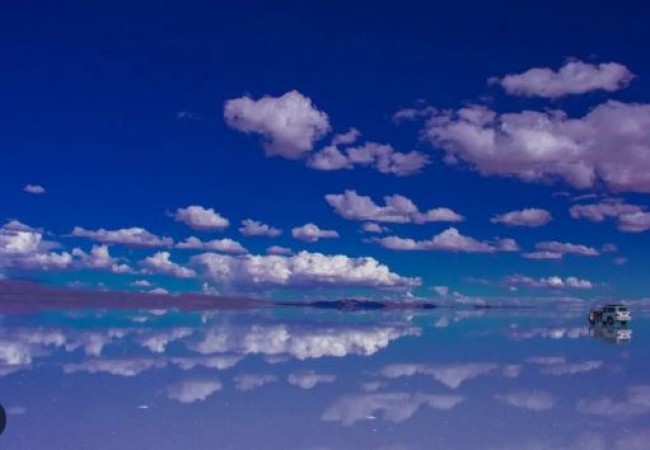
Imagine a vast expanse of blinding white, stretching as far as the eye can see, almost like walking on clouds. This otherworldly landscape exists in Bolivia, and it's called the Salar de Uyuni, one of the most remarkable natural wonders on Earth. In this article, we'll delve into the unique location of the Salar de Uyuni and uncover the intriguing story behind its formation.
What is the Salar de Uyuni?
The Salar de Uyuni is the world's largest salt flat, spanning over 10,000 square kilometers in southwestern Bolivia. This immense area of glistening, hexagonal salt crusts has earned its reputation as a must-visit destination for travelers seeking a truly unique experience.
Geographical Location
Located in the Altiplano region of Bolivia, the Salar de Uyuni is bordered by the Andes Mountains to the north and the Tunupa volcano to the southeast. Its elevation of around 3,656 meters above sea level contributes to the area's stunning vistas and captivating natural phenomena.
Formation: A Prehistoric Lake
Millions of years ago, a prehistoric lake named Lake Minchin covered the region. Over time, geological shifts caused the lake to dry up and split into smaller bodies of water, one of which was Lake Poopó. As Lake Poopó shrank due to climate changes, it left behind the massive salt flats we see today, rich in salt and other minerals.
The Salt Flats' Mirror Effect
During the rainy season, a thin layer of water covers the salt crusts, creating an awe-inspiring mirror effect that reflects the sky above. This mesmerizing sight turns the flats into a photographer's paradise, where the line between the land and the sky blurs, giving an illusion of walking on water.
Beneath the Surface: Lithium Reserves
Beneath the salt crusts lies an astonishingly large reserve of lithium, a valuable mineral used in various industries, including electronics and renewable energy. The Salar de Uyuni holds more than half of the world's known lithium reserves, making it a crucial resource in the modern world.
Wildlife and Flora Adaptations
While the salt flats may seem inhospitable, they are home to unique species that have adapted to the extreme conditions. Flamingos, for example, thrive in the shallow, saline waters around the flats, feasting on the abundance of algae that grow there.
Climate and Weather Patterns
The Salar de Uyuni experiences a cold desert climate, characterized by dryness and temperature fluctuations. Summers bring warmer days, while winters can be freezing. However, due to the altitude, the sun's intensity can be deceiving, and visitors are advised to take precautions against the strong UV rays.
Visiting the Salar de Uyuni
Visitors can access the salt flats through the town of Uyuni. Many tours offer opportunities to explore the flats by foot, bike, or even by jeep. The flats' surreal landscape, along with the unique cactus-covered islands that dot the area, create an unforgettable adventure.
Captivating Photography Opportunities
Photographers flock to the Salar de Uyuni to capture the ethereal beauty of the salt flats. The mirror effect during the rainy season, combined with the clear skies and vastness of the landscape, provides a canvas for breathtaking and surreal photographs.
Sustainability Challenges and Efforts
The popularity of the salt flats among tourists has led to concerns about its environmental impact. Increased foot traffic and waste generation have prompted local authorities and tour operators to implement sustainable practices to preserve this delicate ecosystem.
Cultural Significance
For the indigenous communities living near the Salar de Uyuni, the flats hold cultural significance. The Uru Chipaya people, for instance, have a deep spiritual connection to the area, viewing it as a place of ancestral importance and connection to their roots.
Local Communities and Tourism
Tourism has brought economic opportunities to the region, benefiting local communities. However, it also presents challenges, such as the need to balance economic growth with environmental preservation and the protection of indigenous rights.
Preservation and Conservation
Efforts are underway to strike a balance between tourism and preservation. Strict guidelines regulate the number of visitors, waste disposal, and the use of vehicles on the flats. Initiatives aim to ensure that future generations can continue to enjoy the natural wonder of the Salar de Uyuni.
Future Prospects and Challenges
As technology advances and global demands for resources like lithium increase, the Salar de Uyuni faces both opportunities and challenges. The delicate balance between economic development, cultural preservation, and environmental protection will shape its future. The Salar de Uyuni stands as a testament to the wonders of the natural world. Its unique geographical location, mesmerizing mirror effect, and significant lithium reserves make it a place of fascination, drawing travelers and researchers alike. As we continue to explore and understand this remarkable destination, let's also ensure its preservation for generations to come.
When you travel, you frequently make financial mistakes